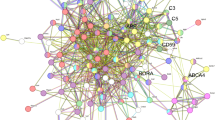Abstract
Background
Nectins are Ca2+-independent immunoglobulin (Ig)-like cell-cell-adhesion molecules. We have generated transgenic mice expressing a series of soluble forms of nectin-1, and investigated special effects of each soluble form of nectin-1 in vivo. In the course of generating transgenic mice expressing a soluble form of nectin-1 consisting of the first Ig-like domain of nectin-1 and the Fc portion of human IgG1 (PHveC-VhIg), we found that all of the transgenic founder mice showed a microphthalmia. The purpose of this study is to examine functions of the extracellular domains of nectin-1 in eye development using transgenic technology.
Methods
Eyes of four different transgenic mouse lines expressing each soluble form of nectin-1 were analyzed histologically. Tissue sections were processed with hematoxylin-eosin staining and indirect immunoperoxidase technique.
Results
All of five transgenic mouse founders expressing PHveC-VhIg, and of three lines expressing PHveC-VpIg made of the first Ig-like domain fused to porcine Fc portions at 5 weeks showed a microphthalmia, but not all of the transgenic mouse lines expressing PHveCIg or PHveCpIg made of the entire ectodomain fused to human or porcine Fc portions. In the abnormal eyes, the vitreous body was almost absent. In PHveC-VhIg-expressing mice at postnatal day 6, each vitreous space was very small. In the neonatal transgenic mice, the vitreous body was almost the same as that of control mice, and PHveC-VhIg was expressed in the optic nerve, conjunctival epithelium, ciliary body, corneal and lens epithelium. At this stage, nectin-1, -3 and -4 were stained in the optic nerve of control mice as well as in that of the transgenic mice. Nectin-1 is faintly stained in the epithelium of the cornea and lens epithelium, but not in the ciliary body.
Conclusion
Soluble forms of the first Ig-like domain of nectin-1 (PHveC-VhIg and PHveC-VpIg), but not those of the entire ectodomain (PHveCIg and PHveCpIg), lead to microphthalmia and lack of vitreous body in the transgenic mice.






Similar content being viewed by others
References
Cocchi F, Lopez M, Menotti L, Aoubala M, Dubreuil P, Campadelli-Fiume G (1998) The V domain of herpesvirus Ig-like receptor (HIgR) contains a major functional region in herpes simplex virus-1 entry into cells and interacts physically with the viral glycoprotein D. Proc Natl Acad Sci USA 95:15700–15705
Fabre S, Reymond N, Cocchi F, Menotti L, Dubreuil P, Campadelli-Fiume G, Lopez M (2002) Prominent role of the Ig-like V domain in trans-interactions of nectins. Nectin3 and nectin 4 bind to the predicted C-C′-C″-D beta-strands of the nectin1 V domain. J Biol Chem 277:27006–27013
Geraghty RJ, Krummenacher C, Cohen GH, Eisenberg RJ, Spear PG (1998) Entry of alphaherpesviruses mediated by poliovirus receptor-related protein 1 and poliovirus receptor. Science 280:1618–1620
Inagaki M, Irie K, Ishizaki H, Tanaka-Okamoto M, Morimoto K, Inoue E, Ohtsuka T, Miyoshi J, Takai Y (2005) Roles of cell-adhesion molecules nectin 1 and nectin 3 in ciliary body development. Development 132:1525–1537
Ito M, Yoshioka M (1999) Regression of the hyaloid vessels and pupillary membrane of the mouse. Anat Embryol (Berl) 200:403–411
Nakagawa I, Murakami M, Ijima K, Chikuma S, Saito I, Kanegae Y, Ishikura H, Yoshiki T, Okamoto H, Kitabatake A, Uede T (1998) Persistent and secondary adenovirus-mediated hepatic gene expression using adenovirus vector containing CTLA4IgG. Hum Gene Ther 9:1739–1745
Niwa H, Yamamura K, Miyazaki J (1991) Efficient selection for high-expression transfectants with a novel eukaryotic vector. Gene 108:193–200
Okabe N, Ozaki-Kuroda K, Nakanishi H, Shimizu K, Takai Y (2004) Expression patterns of nectins and afadin during epithelial remodeling in the mouse embryo. Dev Dyn 230:174–186
Ono E, Amagai K, Taharaguchi S, Tomioka Y, Yoshino S, Watanabe Y, Cherel P, Houdebine LM, Adam M, Eloit M, Inobe M, Uede T (2004) Transgenic mice expressing a soluble form of porcine nectin-1/herpesvirus entry mediator C as a model for pseudorabies-resistant livestock. Proc Natl Acad Sci USA 101:16150–16155
Ono E, Amagai K, Yoshino S, Taharaguchi S, Inobe M, Uede T (2004) Resistance to pseudorabies virus infection in transformed cell lines expressing a soluble form of porcine herpesvirus entry mediator C. J Gen Virol 85:173–178
Ono E, Tomioka Y, Watanabe Y, Amagai K, Morimatsu M, Shinya K, Cherel P (2007) Comparison of the antiviral potentials among the pseudorabies-resistant transgenes encoding different soluble forms of porcine nectin-1 in transgenic mice. J Gen Virol 88:2636–2641
Ono E, Tomioka Y, Watanabe Y, Amagai K, Taharaguchi S, Glenisson J, Cherel P (2006) The first immunoglobulin-like domain of porcine nectin-1 is sufficient to confer resistance to pseudorabies virus infection in transgenic mice. Arch Virol 151:1827–1839
Ozaki-Kuroda K, Nakanishi H, Ohta H, Tanaka H, Kurihara H, Mueller S, Irie K, Ikeda W, Sakai T, Wimmer E, Nishimune Y, Takai Y (2002) Nectin couples cell-cell adhesion and the actin scaffold at heterotypic testicular junctions. Curr Biol 12:1145–1150
Taharaguchi S, Yoshida K, Tomioka Y, Yoshino S, Uede T, Ono E (2005) Persistent hyperplastic primary vitreous in transgenic mice expressing IE180 of the pseudorabies virus. Invest Ophthalmol Vis Sci 46:1551–1556
Takai Y, Nakanishi H (2003) Nectin and afadin: novel organizers of intercellular junctions. J Cell Sci 116:17–27
Valyi-Nagy T, Sheth V, Clement C, Tiwari V, Scanlan P, Kavouras JH, Leach L, Guzman-Hartman G, Dermody TS, Shukla D (2004) Herpes simplex virus entry receptor nectin-1 is widely expressed in the murine eye. Curr Eye Res 29:303–309
Acknowledgements
This study was supported by Grants-in-Aid for Scientific Research (C)(2) from The Ministry of Education, Culture, Sports, Science and Technology, Japan. We thank Dr. J. Miyazaki for pCXN2.
Author information
Authors and Affiliations
Consortia
Corresponding author
Additional information
Transgenic mice generating group: Keiko Amagai, Minako Kuramochi, Yuki Watanabe and Shigeto Kouda (Sankyo Labo Service Corporation, Tokyo 132-0023, Japan).
Rights and permissions
About this article
Cite this article
Yoshida, K., Tomioka, Y., Kase, S. et al. Microphthalmia and lack of vitreous body in transgenic mice expressing the first immunoglobulin-like domain of nectin-1. Graefes Arch Clin Exp Ophthalmol 246, 543–549 (2008). https://doi.org/10.1007/s00417-007-0750-y
Received:
Revised:
Accepted:
Published:
Issue Date:
DOI: https://doi.org/10.1007/s00417-007-0750-y




